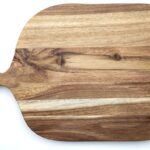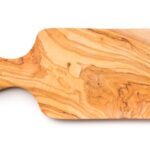Wood is one of the oldest materials used to make kitchen utensils and remains very popular due to its performance and natural beauty. Many types of wood are used to make cooking accessories, but not all woods are created equal. Some types of wood are safe for making items that come into contact with food, while others should be avoided.
When it comes to choosing the right wood for your cooking utensils, only hardwood is tough enough to ensure its durability. Hardwood has denser wood fibers and is less likely to soak up water than softwood. The most commonly used hardwoods for making kitchen utensils are acacia, hard maple, cherry, and walnut.
Another important feature of wood material is food safety, meaning that wood shouldn’t contain harmful substances. In addition, the wooden surface should be sealed with food-grade oil.
Finally, aesthetically pleasing wood materials can add charm and a rustic feel to the kitchen.
The Best Wood for Wooden Spoons, Spatulas, and Spurtles
With their long handles, wooden spoons are comfortable to hold. Because wood doesn’t conduct heat, you can use it to stir without worrying about burning your fingers. In contrast to metal utensils, which are quite loud, wooden spoons are pleasantly quiet when working.
It seems that wood is an excellent choice for kitchen spoons, spatulas, and spoons, but this is not true for all types of wood.
Fruit trees such as pear, plum, apple, cherry, teak, and walnut are good materials for making kitchen spoons because they are durable and non-toxic. Teak contains oil, making it more water-resistant than other types of wood used to make kitchen spoons.
Olive wood is very strong, dirt-repellent, decorative, and easy to care for. However, using olive wood in contact with food may cause an allergic reaction in some people. Although these allergic reactions are rare, olive wood can cause symptoms such as sneezing and scratchy throat.
Despite their attractive appearance, exotic trees may not be a healthy option for making kitchen items. Some substances that these trees naturally produce to control insects can be harmful to health.
This post contains links to Amazon. The publisher may get paid if You purchase something through the links without additional costs to You.
Wooden Utensils for Cooking Set with Holder
Wood for Making Cutting Boards
Choosing the appropriate wood for a cutting board is crucial for successful food preparation and also for protecting the edge of your knife blade. The most important criteria when selecting wood for cutting boards include hardness, absence of toxic ingredients, ease of care, and decorative appearance. The right mix of softness and hardness is an ideal option as some hardwoods such as teak can dull knife blades. The most suitable cutting board materials are maple, walnut, cherry, and acacia. The decorative look of the wood should not be neglected, with cherry, walnut, and maple standing out in their unique way. Due to their slightly darker color, cherry and walnut have the advantage that food stains are less visible and do not affect their attractive appearance. Cherry can also heal itself to restore knife cut marks.
To ensure the conservation of natural resources, the use of wood for the production of kitchen products must be sustainable. Walnuts, maples, and cherries are considered renewable raw materials because they grow very quickly.
Maple wood has a creamy white color and is prone to picking up stains if not sealed properly. With good care and regular sealing, utensils made from maple wood last longer than those made from other woods.
What Woods to Avoid for Cutting Boards?
Softwood such as pine, balsa, or cedar is not suitable for cutting boards because softwood is prone to warping and cracking.
Porous cutting boards, such as those made of ash or red oak, are not easy to keep clean as bacteria and fungi can multiply on them.
Wood that contains toxic substances should be avoided at all costs. For example, Purpleheart is a very attractive material for making some wooden items but is not suitable for making kitchen utensils. Purpleheart wood contains substances that may cause eye and skin irritation. Rosewood, American mahogany, and teak also contain toxic substances.
Best Wood for Salad Bowls
Hardwoods like cherry, acacia, black walnut, and maple are the best types of wood for making salad bowls. Hardwood does not require the addition of fillers for durability and long-lasting performance.
To be on the safe side, choose bowls that have a natural color. Wood stains are used to give wood a darker or more attractive appearance, but they may contain pigments that are not food-safe.
Cherry wood is the best choice for making salad bowls as it has the necessary strength and a beautiful reddish-brown color that looks beautiful on the table. Over time it becomes darker and even more beautiful.
Acacia is a very strong hardwood with long-lasting quality. Acacia wood is rich in contrasting colors that create a rustic, elegant look.
The black walnut wood is a fine-grained hardwood that ranges from chocolate brown to yellow. This hardwood is valued for its strength and deep, rich color. Mineral oil is the only thing it needs to bring out its beautiful color.
Salad bowls made from wood that lacks strength, such as birch, should be avoided. Birchwood is susceptible to damage and warping. Although it looks beautiful, it requires a lot of care to resist moisture and damage.
Oak is also prone to cracking and damage, so your bowl won’t last long.
Some types of wood, such as beech, can change color and lose their attractiveness over time.
Wooden Spoons Utensils for Cooking
Wood Salad Servers
Serving salad in wooden bowls requires appropriate serving accessories such as salad tongs, salad hands, and salad spoons and forks.
When it comes to salad servers, they should be made of hardwood that is safe for food preparation. People often choose wooden accessories to complement their wooden salad bowls. Cherry, acacia, black walnut, and maple are the best options when it comes to the durability, safety, and attractive appearance of salad serving tools.
Which Oil to Use for Sealing Wooden Utensils
Most of the oils we use for cooking are not suitable for oiling wooden kitchen utensils. These oils can easily become rancid, which negatively affects the taste of food. Food-grade mineral oil is the best option for sealing wooden kitchen utensils. This oil makes the wood surface water-resistant and reduces the risk of cracks. Mineral oil is easy to apply and does not go rancid. Just make sure to reapply regularly to keep the surface water-resistant and shiny.
If you need to restore the damaged utensils, remove imperfections with sandpaper and then reapply the protective layer of mineral oil.
Easy-Applicator Mineral Oil for Cutting Boards and All Wood Care
The Takeaway
Even if you don’t make your own kitchen utensils, you can still choose the materials your utensils are made of. You can do this by purchasing kitchen items from reliable kitchen appliance manufacturers. Wooden utensils should be accompanied by detailed information about the wood material and other characteristics that may be important to customers. When shopping online, pay attention to the product description and only buy from reputable domestic manufacturers and sellers.



